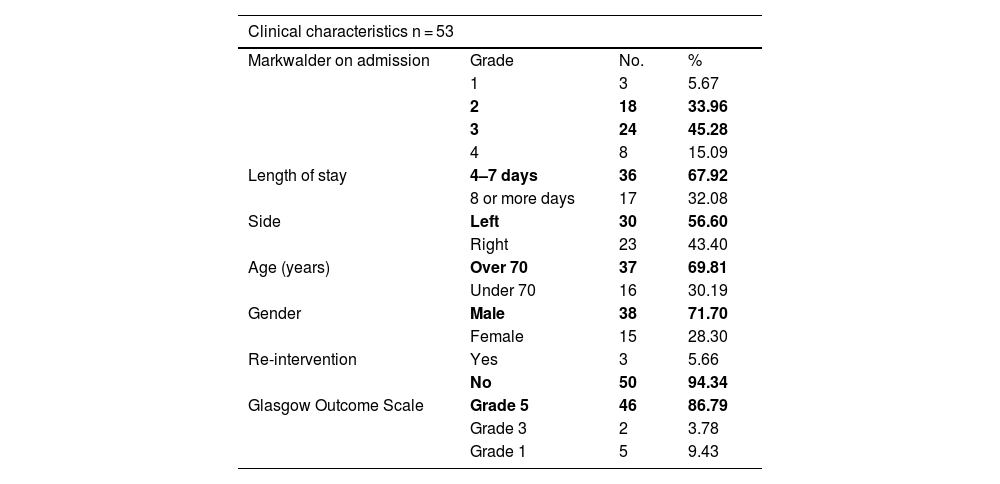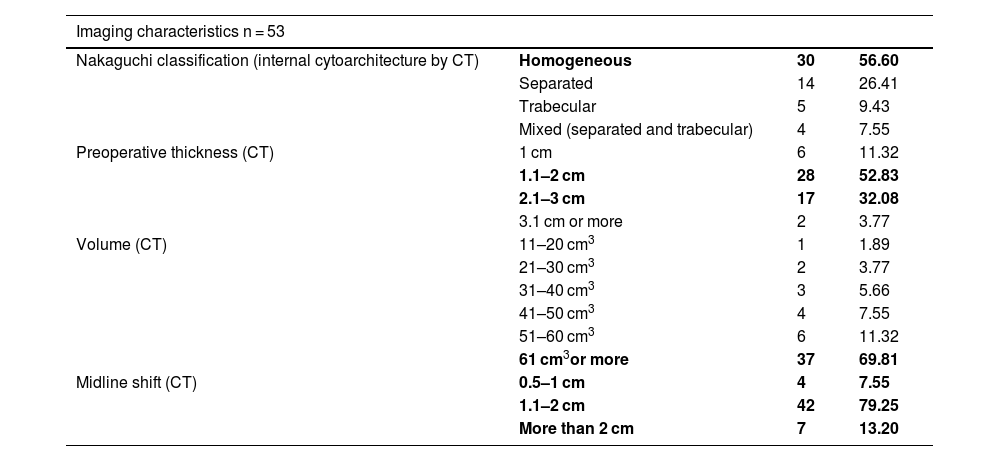Chronic subdural hematoma is one of the most common diseases in neurosurgical practice. The content of electrolytes and gases in the collection could participate in the growth and expansion mechanism, however, there is no evidence that they have been studied before. The objective has been to identify electrolyte, gas and internal metabolomic markers of the content of chronic subdural hematomas, with the possibility of participating in their growth and expansion and to substantiate a pathophysiological hypothesis that interacts with existing ones.
Material and methodA descriptive study was carried out with 53 patients operated on for chronic subdural hematoma, at the “Roberto Rodríguez Fernández” General Teaching Hospital of Morón in Ciego de Ávila, Cuba, in the period between January 2019 and December 2023. The diagnoses were obtained with computed axial tomography. The electrolyte and blood gas components of hematomas are correlated with clinical and neuroimaging variables.
ResultsPatients over 70 years of age predominated, 37 (69.81%) and males 38 (71.70%). The Markwalder scale upon admission showed a predominance of Grade III in 24 cases (45.28%). The Glasgow outcome scale showed a predominance of Grade V, 31 (58.49%).
ConclusionsElectrolyte and gasometric metabolomic markers of subdural blood can promote the phenomenon of progressive growth and expansion and have a synergistic effect with the rest of the pathophysiological mechanisms.
El hematoma subdural crónico es una de las enfermedades más frecuentes en la práctica neuroquirúrgica. El contenido de electrolitos y gases en la colección, pudieran participar en el mecanismo de crecimiento y expansión sin embargo, no hay evidencias de que hayan sido estudiados antes. El objetivo ha sido identificar los marcadores metabolómicos electrolíticos, de gases y en el medio interno del contenido de los hematomas subdurales crónicos, con posibilidades de participar en su crecimiento y expansión y fundamentar una teoría fisiopatológica que interactúe con las ya existentes.
Material y métodoSe realizó un estudio correlacional descriptivo con 53 pacientes operados por hematoma subdural crónico, en el Hospital General Docente “Roberto Rodríguez” de Morón en Ciego de Ávila, Cuba, en el periodo entre enero del 2019 y diciembre del 2023. Los diagnósticos se obtuvieron con tomografía axial computada. Se correlacionan los componentes electrolíticos y gasométricos de los hematomas con variables clínicas y de neuroimágenes.
ResultadosPredominaron los enfermos mayores de 70 años, 37 (69,81%) y el sexo masculino 38 (71,70%). La escala de Markwalder al ingreso evidenció un predominio de los Grados III en 24 casos (45,28%). La escala de resultados de Glasgow mostró un predominio del Grado V, 31 (58,49%).
ConclusionesLos marcadores metabolómicos electrolíticos y gasométricos de la sangre subdural pueden propiciar el fenómeno de crecimiento y expansión progresivos y tener un efecto sinérgico con el resto de los mecanismos fisiopatológicos.
Article

If it is the first time you have accessed you can obtain your credentials by contacting Elsevier Spain in suscripciones@elsevier.com or by calling our Customer Service at902 88 87 40 if you are calling from Spain or at +34 932 418 800 (from 9 to 18h., GMT + 1) if you are calling outside of Spain.
If you already have your login data, please click here .
If you have forgotten your password you can you can recover it by clicking here and selecting the option ¿I have forgotten my password¿.









